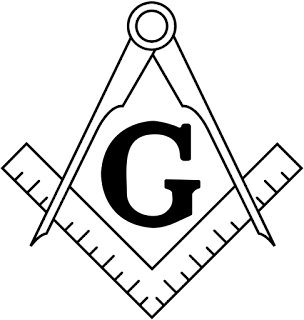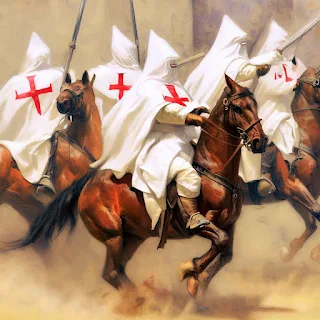 |
| by MesserWoland |
The Freemasons are one of the most secretive and controversial organizations in the world. They claim to be a fraternal society that promotes morality, charity, and enlightenment, but they have also been accused of being a powerful and sinister group that manipulates world events and holds hidden privileges. Who are the Freemasons and where did they come from? In this article, we will explore some of the historical and symbolic aspects of this mysterious order.
The Knights Templar Connection
One of the most popular theories about the origins of the Freemasons is that they are descended from the Knights Templar, a medieval military order that was established to protect pilgrims in the Holy Land during the Crusades. The Knights Templar became very wealthy and influential, but they also faced persecution from the Church and the kings of Europe, who accused them of heresy, blasphemy, and treason. Many Templars were arrested, tortured, and executed, while others escaped and went into hiding.
Some historians believe that some of the surviving Templars fled to Scotland, where they found refuge with Robert the Bruce, who was excommunicated by the Pope for rebelling against England. There, they allegedly helped him win the Battle of Bannockburn in 1314, and later formed a secret society that evolved into the Scottish Rite of Freemasonry. Others suggest that some Templars joined other orders, such as the Knights Hospitaller or the Teutonic Knights, or formed their own independent groups in various countries.
The Pirate Connection
Another theory is that some of the Templars who escaped persecution became pirates, and used their naval skills and connections to raid ships and ports across the Mediterranean and Atlantic. They also adopted a new symbol, the Jolly Roger flag, which is said to have originated from the skull and crossbones on the grave of their last Grand Master, Jacques de Molay, who was burned at the stake in 1314. The Jolly Roger flag was a way of identifying themselves as outlaws and enemies of the Church and the crown, as well as a means of intimidating their victims.
Some of the most famous pirates who were allegedly linked to the Templars were Henry Avery, who was known as the King of Pirates; Edward Teach, better known as Blackbeard; and Bartholomew Roberts, who was called Black Bart. Some historians claim that these pirates were not only motivated by greed and adventure, but also by a secret mission to find and protect the legendary treasure of the Templars, which was rumored to include relics, documents, and artifacts of great value and power.
The Compass and Triangle Symbol
The most recognizable symbol of the Freemasons is the compass and triangle, which are tools used by builders and architects. The compass represents the heavens, or the spiritual realm, while the triangle represents the earth, or the material world. Together, they symbolize the harmony between these two realms, as well as the balance between reason and faith. The compass also signifies the ability to measure and limit one’s actions and desires, while the triangle signifies morality and justice. The letter G in the center stands for God, Geometry, or both.
The compass and triangle symbol is also related to the legend of King Solomon’s Temple, which is a central theme in Freemasonry. According to Masonic tradition, King Solomon hired a master builder named Hiram Abiff to construct his temple in Jerusalem. Hiram Abiff possessed a secret word that gave him access to the inner sanctum of the temple, where he could communicate with God. However, he was murdered by three fellow workers who wanted to steal his secret. King Solomon then sent out twelve fellow craftsmen to find his body and recover his word. They found his body buried under a sprig of acacia, but they could not recover his word. Instead, they agreed on a substitute word that would be used until the original word was found.
The legend of Hiram Abiff is reenacted in one of the rituals of Freemasonry, where candidates are initiated into different degrees or levels of membership. The first degree is called Entered Apprentice, where candidates learn about the basic principles and symbols of Freemasonry. The second degree is called Fellow Craft, where candidates learn about the liberal arts and sciences that are essential for human progress. The third degree is called Master Mason, where candidates experience the death and resurrection of Hiram Abiff and learn about his secret word.
The Illuminati Connection
Another source of controversy and conspiracy theories about the Freemasons is their alleged connection to another secret society called the Illuminati. The Illuminati were a group of Enlightenment thinkers who were founded in Bavaria in 1776 by Adam Weishaupt. They opposed superstition, prejudice, religious influence over public life, and abuses of state power. They also sought to create a new world order based on reason, freedom, and equality. However, they were banned by the Bavarian government in 1785 and forced to disband.
Some conspiracy theorists believe that the Illuminati did not really disappear, but instead infiltrated the Freemasons and other organizations, and continued to work behind the scenes to manipulate world events and achieve their goals. They also claim that the Illuminati use various symbols and signs to communicate with each other and to signal their influence and power. One of the most famous symbols associated with the Illuminati is the Eye of Providence, or the all-seeing eye, which is depicted on the U.S. dollar bill. This symbol is also used by the Freemasons, who interpret it as a reminder of God’s omniscience and omnipresence.
Conclusion
The Freemasons are a fascinating and mysterious organization that has a long and complex history. They have been influenced by various groups and movements, such as the Knights Templar, the pirates, and the Illuminati, and they have also influenced many aspects of culture, politics, and society. They have a rich and symbolic tradition that reflects their values and beliefs, as well as their secrets and mysteries. Whether they are seen as a benevolent and charitable fraternity or a malevolent and conspiratorial cabal, the Freemasons continue to intrigue and inspire people around the world.






No comments:
Post a Comment